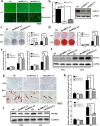Aldo-keto reductase family 1 member C1 regulates the osteogenic differentiation of human ASCs by targeting the progesterone receptor
- PMID: 34233738
- PMCID: PMC8261971
- DOI: 10.1186/s13287-021-02425-3
Aldo-keto reductase family 1 member C1 regulates the osteogenic differentiation of human ASCs by targeting the progesterone receptor
Abstract
Background: As a promising way to repair bone defect, bone tissue engineering has attracted a lot of attentions from researchers in recent years. Searching for new molecular target to modify the seed cells and enhance their osteogenesis capacity is one of the hot topics in this field. As a member of aldo-keto reductase family, aldo-keto reductase family 1 member C1 (AKR1C1) is reported to associate with various tumors. However, whether AKR1C1 takes part in regulating differentiation of adipose-derived mesenchymal stromal/stem cells (ASCs) and its relationship with progesterone receptor (PGR) remain unclear.
Methods: Lost-and-gain-of-function experiments were performed using knockdown and overexpression of AKR1C1 to identify its role in regulating osteogenic and adipogenic differentiation of hASCs in vitro. Heterotypic bone and adipose tissue formation assay in nude mice were used to conduct the in vivo experiment. Plasmid and siRNA of PGR, as well as western blot, were used to clarify the mechanism AKR1C1 regulating osteogenesis.
Results: Our results demonstrated that AKR1C1 acted as a negative regulator of osteogenesis and a positive regulator of adipogenesis of hASCs via its enzyme activity both in vitro and in vivo. Mechanistically, PGR mediated the regulation of AKR1C1 on osteogenesis.
Conclusions: Collectively, our study suggested that AKR1C1 could serve as a regulator of osteogenic differentiation via targeting PGR and be used as a new molecular target for ASCs modification in bone tissue engineering.
Keywords: AKR1C1; Adipose-derived mesenchymal stromal/stem cells; Osteogenesis; Progesterone receptor.
Conflict of interest statement
The authors declare that they have no competing interests.
Figures





References
Publication types
MeSH terms
Substances
LinkOut - more resources
Full Text Sources
Medical
Research Materials

